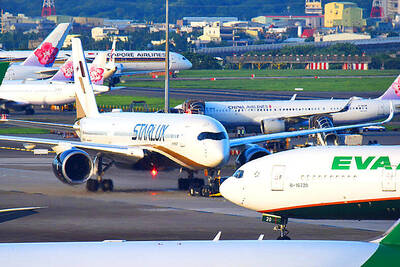The military has concluded a series of simulated cyber warfare maneuvers in which the various branches of the armed forces conducted mock counterattacks on China's coastal military targets following a surprise attack by China, military sources said yesterday.
The round-the-clock five-day computerized warfare simulation, which ended on Friday, was part of the annual "Han Kuang" series of combined services military exercises aimed at honing combat strategies and battlefield management tactics, the sources said.
This year's cyber wargames also marked the first time the armed forces practiced counterattack strategies and skills in simulated warfare drills, the sources said, adding that in the mock counterattacks, Taiwanese troops struck coastal Chinese military targets and booming cities with such weapons as cruise missiles and short-range ballistic missiles.
The military's Joint Operations Command Center, the Joint Operations Training Center and tactical command offices at various strategic military units took part in the computerized maneuvers, the sources said, adding that a US delegation, headed by former Pacific Command commander-in-chief Admiral Dennis Blair, was on hand to observe the process.
The Ministry of National Defense is scheduled to brief the press on the details of the "Han Kuang 23" maneuvers at its routine news conference on Tuesday, the sources said.
Sources also said that the wargame scenario was set in 2012 at a time when China, frustrated by Taiwan's long-term resistance to unification talks, decides to take advantage of Taiwan's procrastination in military arsenal upgrades to accelerate its push for unification by launching an all-out surprise attack on Taiwan proper and its outlying island of Penghu.
In the first three days of the simulated Chinese invasion, Taiwan incurred severe human and material losses from China's saturation ballistic missile assault as well as naval and aerial bombardment.
Afterwards, Taiwan's armed forces managed to stage counterattacks on China's coastal military targets and major cities, causing heavy human casualties and major destruction.
In the scenario, the military strikes had a heavy toll on the economic wellbeing of both sides of the Taiwan Strait and adversely impacted the global economy, causing worldwide panic. In the end, the US and other Western countries mediated a ceasefire.
In a departure from media speculation, however, the wargames did not cover the use of nuclear weapons or Taiwanese attacks on Chinese aircraft carrier battle groups, the sources said.
Meanwhile, the US observation group paid special attention to Taiwanese military personnel's "combat spirit" to determine if morale had been affected by the political infighting that followed the transition of power in 2000.
In weighing the military's "combat spirit," the sources said, the US delegation wanted to determine whether Taiwan would likely lean toward China and whether any advanced US-built weapons systems or sophisticated defense plans would end up in Beijing's hands.
Following the completion of the maneuvers, the military would in initiate a five-day psychological warfare training program aimed at enhancing service members' combat morale, battlefield adaptability and stress management.
The "Han Kuang" series is the largest combined services military exercise in Taiwan. In addition to the computer wargames, it covers live-fire military maneuvers, which will be held later this year.

Trips for more than 100,000 international and domestic air travelers could be disrupted as China launches a military exercise around Taiwan today, Taiwan’s Civil Aviation Administration (CAA) said yesterday. The exercise could affect nearly 900 flights scheduled to enter the Taipei Flight Information Region (FIR) during the exercise window, it added. A notice issued by the Chinese Civil Aviation Administration showed there would be seven temporary zones around the Taiwan Strait which would be used for live-fire exercises, lasting from 8am to 6pm today. All aircraft are prohibited from entering during exercise, it says. Taipei FIR has 14 international air routes and

Taiwan lacks effective and cost-efficient armaments to intercept rockets, making the planned “T-Dome” interception system necessary, two experts said on Tuesday. The concerns were raised after China’s military fired two waves of rockets during live-fire drills around Taiwan on Tuesday, part of two-day exercises code-named “Justice Mission 2025.” The first wave involved 17 rockets launched at 9am from Pingtan in China’s Fujian Province, according to Lieutenant General Hsieh Jih-sheng (謝日升) of the Office of the Deputy Chief of the General Staff for Intelligence at the Ministry of National Defense. Those rockets landed 70 nautical miles (129.6km) northeast of Keelung without flying over Taiwan,

City buses in Taipei and New Taipei City, as well as the Taipei MRT, would on Saturday begin accepting QR code payments from five electronic payment providers, the Taipei Department of Transportation said yesterday. The new option would allow passengers to use the “transportation QR code” feature from EasyWallet, iPass Money, iCash Pay, Jkopay or PXPay Plus. Passengers should open their preferred electronic payment app, select the “transportation code” — not the regular payment code — unlock it, and scan the code at ticket readers or gates, General Planning Division Director-General Liu Kuo-chu (劉國著) said. People should move through the

The Ministry of National Defense (MND) today released images of the military tracking China’s People's Liberation Army (PLA) movements during the latest round of Chinese drills around Taiwan. The PLA began "Justice Mission 2025" drills today, carrying out live-fire drills, simulated strikes on land and maritime targets, and exercises to blockade the nation's main ports. The exercises are to continue tomorrow, with the PLA announcing sea and air space restrictions for five zones around Taiwan for 10 hours starting from 8:30am. The ministry today released images showing a Chinese J-16 fighter jet tracked by a F-16V Block 20 jet and the